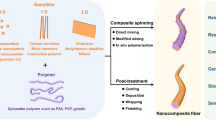Abstract
Hyaluronic acid-based nanofiber scaffolds imitating the natural extracellular matrix, which is promising for use in tissue engineering, have been prepared by electrospinning. Hyaluronic acid is part of many organs and tissues; it is a biologically active component capable of being involved in cell proliferation and migration. The high viscosity of solutions of the macromolecular biopolymer significantly complicates the preparation of nanofiber scaffolds based on it. Rheological studies have made it possible to determine the solvent composition that contributes to a decrease in the viscosity of the spinning solution. The highest Newtonian viscosity of a 1% hyaluronic acid solution in water is 25 Pa s; in the case of using a mixture of ammonia hydrate (10%) and dimethylformamide at a ratio of 2 : 1, this parameter decreases to 1.147 Pa s. The use of a special spinning cell with a small-diameter nozzle and a high pressure (up to 10 atm) has provided the formation of hyaluronic acid-based nanofibers with a diameter of 100–300 nm.








Similar content being viewed by others
REFERENCES
Y. Li, Y. Xiao, and C. Liu, Biomaterials 31, 4639 (2010). https://doi.org/10.1021/acs.chemrev.6b00654
M. J. Fullana and G. E. Wnek, Drug Deliv. Transl. Res. 2, 313 (2012). https://doi.org/10.1007/s13346-012-0087-x
T. Wu, H. Zheng, J. Chen, et al., J. Mater. Chem. B 5, 139 (2017). https://doi.org/10.1039/C6TB02484J
V. Llopis-Hernandez, M. Cantini, C. Gonzalez-Garcia, and M. Salmeron-Sanchez, Int. Mater. Rev. 60, 245 (2014). https://doi.org/10.1179/1743280414Y.0000000049
M. Arnal-Pastor, C. Martínez Ramos, M. Pérez Garnés, et al., Mater. Sci. Eng. C 33, 4086 (2013). https://doi.org/10.1016/j.msec.2013.05.058
J. M. Cyphert, C. S. Trempus, and S. Garantziotis, Int. J. Cell Biol. 7, 563818 (2015). https://doi.org/10.1155/2015/563818
A. Maleki, A.-L. Kjøniksen, and B. Nyström, Polym. Bull. 59, 217 (2007). https://doi.org/10.1007/s00289-007-0760-2
A. Fallacara, E. Baldini, S. Manfredini, and S. Vertuani, Polymers (Basel) 10, 701 (2018). https://doi.org/10.3390/polym10070701
M. F. P. Gracaa, S. P. Miguela, C. S. D. Cabral, and I. J. Correia, Carbohyd. Polym. 241, 116364 (2020). https://doi.org/10.1016/j.carbpol.2020.116364
A. de Pieri, A. M. Byerley, C. R. Musumeci, et al., Spine 3, e1117 (2020). https://doi.org/10.1002/jsp2.1117
M. Abrigo, S. L. McArthur, and P. Kingshott, Macromol. Biosci. 14, 772 (2014). https://doi.org/10.1002/mabi.201300561
Y. Liaoa, Ch.-H. Loha, M. Tiana, et al., Prog. Polym. Sci. 77, 69 (2018). https://doi.org/10.1016/j.progpolymsci.2017.10.003
E. K. Brenner, J. D. Schiffman, E. A. Thompson, et al., Carbohyd. Polym. 87, 926 (2012). https://doi.org/10.1016/j.carbpol.2011.07.033
E. Pabjańczyk-Wlazło, P. Król, I. Krucińska, et al., Adv. Polym. Technol. 37, 1929 (2018). https://doi.org/10.1002/adv.21851
E. Pabjańczyk-Wlazło, I. Krucińska, M. Chrzanowski, et al., Fibres Text. East. Eur. 25, 45 (2017). https://doi.org/10.5604/12303666.1237225
M. Cowman, T. A. Schmidt, P. Raghavan, and A. Stecco, F1000 Res. 4, 622 (2015). https://doi.org/10.12688/f1000research.6885.1
I. Gatej, M. Popa, and M. Rinaudo, Biomacromolecules 6, 61 (2005). https://doi.org/10.1021/bm040050m
M. M. Demir, I. Yilgor, E. Yilgor, and B. Erman, Polymer 43, 3303 (2002). https://doi.org/10.1016/S0032-3861(02)00136-2
C. Mituppatham, M. Nithitanakul, and P. Supaphol, Macromol. Chem. Phys. 205, 2327 (2004). https://doi.org/10.1002/macp.200400225
P. Gupta, C. Elkins, T. E. Long, and G. L. Wilkes, Polymer 46, 4799 (2005). https://doi.org/10.1016/j.polymer.2005.04.021
J. Li, A. He, Ch. C. Han, et al., Macromol. Rapid Commun. 27, 114 (2006). https://doi.org/10.1002/marc.200500726
Ah. Esmaeilirad, J. Ko, M. Vrukosuyev, et al., Mater. Res. Express 4, 015302 (2017). https://doi.org/10.1088/2053-1591/4/1/015302
Ch. S. Kong, S. G. Lee, S. H. Lee, et al., J. Macromol. Sci. B 50, 528 (2011). https://doi.org/10.1080/00222341003784386
R. Stern, G. Kogan, M. J. Jedrzejas, and L. Šoltés, Biotechnol. Adv. 25, 537 (2007). https://doi.org/10.1016/j.biotechadv.2007.07.001
Funding
This work was supported by the Russian Foundation for Basic Research and the Government of Moscow (project no. 19-33-70071 mol_a_mos).
Author information
Authors and Affiliations
Corresponding author
Additional information
Translated by M. Timoshinina
Rights and permissions
About this article
Cite this article
Tenchurin, T.K., Shepelev, A.D., Belousov, S.I. et al. Production of Nanofiber Materials Based on Macromolecular Hyaluronic Acid by Electrospinning. Nanotechnol Russia 16, 89–95 (2021). https://doi.org/10.1134/S2635167621010092
Received:
Revised:
Accepted:
Published:
Issue Date:
DOI: https://doi.org/10.1134/S2635167621010092




